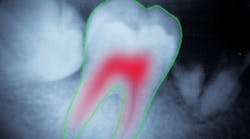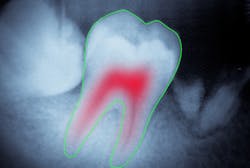Meet the computer vision systems that will revolutionize global dentistry. Already, CAD systems look for signs of tooth pathology that can be spotted in dental x-rays and cone-beam computed tomography (CBCT) images. Dr. Oskana Bandura talks about these algorithms that will soon become must-have tools in digital dental offices of the future.
Editor's note: This article first appeared in DE's Breakthrough Clinical with Stacey Simmons, DDS. Find out more about the clinical specialties newsletter created just for dentists, and subscribe here.
If you found out that your dentist was a robot, would it scare or rather encourage you? Machines perform better in many tasks requiring precision, but they still lack human insight and creativity, which are attributes most intellectual jobs need. It is unlikely that machines will ever replace humans in such a complex area as dentistry, but intelligent software can still help medical practitioners detect typical signs and classify them according to certain rules, and this is exactly what computer-aided detection and diagnosis systems (CAD) do. Based on image analysis algorithms, these systems support physicians working with medical images. IN DENTISTRY, CAD SYSTEMS LOOK FOR SIGNS OF ANY TOOTH PATHOLOGY THAT CAN BE SPOTTED IN DENTAL X-RAY OR CONE-BEAM COMPUTED TOMOGRAPHY (CBCT) IMAGES.
Caries
It is vital to detect caries in a timely manner to prevent further complications. Besides that, caries in its early stages often can be cured without excessive drilling but through a set of remineralizing procedures. So, it would be great not only to detect caries but also to determine its depth by some noninvasive and enamel-sparing methods.
Visual inspection and bitewing radiography are two of the most common methods for caries detection. X-ray examination is especially good at revealing interproximal caries that appears between the contacting surfaces of two adjacent teeth and thus is difficult to detect with the naked eye. To enhance the efficiency of both optical and x-ray analysis, computer science suggests the use of dental CAD systems that allow not only for caries detection but also for its classification, depending on the estimated depth of a lesion.
ALSO BY DR. BANDURA |How new dental imaging can save the lives your patients
During the last decade, scientists have introduced several systems based on various machine-learning classification methods, such as SVMs, neural networks, and random forests. Although some progress has been shown, the success rate of caries detection in bitewing radiography is still insufficient. At the International Symposium on Biomedical Imaging (ISBI) 2015, computer-automated segmentation of caries in bitewing radiography was defined as one of the grand challenges in dental image analysis, and, according to the results achieved (1), the problem remains unsolved.
However, some promising results have been achieved in automated caries detection through optical images. (2) Automated location of carious lesions in the images of the occlusal tooth surface can help dentists in some challenging cases, such as early caries in abnormally inclined teeth. The research proposes a complex dental image analysis system based on advanced segmentation and feature extraction techniques accompanied by a super-classifier. The latter is composed of four classification methods: C4.5 decision tree, SVM, random forest, and artificial neural network,and has been used to score carious lesions according to the International Caries Detection and Assessment System (ICDAS). The system’s accuracy amounted to 86.3%, specificity to 91.7%, and sensitivity to 83.0%, which is a good start.
Root canals
One essential thing about root canal treatment is that it must be complete but not excessive. It is particularly important that endodontic treatment be accompanied by a detailed x-ray or CBCT examination of affected roots with the most precise measurement of root canal length and shape. But this task can pose challenges, particularly when a tooth has multiple canals and/or severely curved canals. To address this problem, dentists may call for a second-reader support of a dental image analysis system. By now, scientists have proposed many approaches to root canal identification and measurement.
One paper suggests a method based on a linear prediction model for root canal edge detection and segmentation in plane x-ray images, but the accuracy achieved is below 85% (3), which is likely not enough for real-world use.
Another study suggests analyzing micro-CT and CBCT slices instead. Applying computer vision algorithms to high-resolution slices creates a 3-D model of a root canal that reflects its shape with sufficient precision. The proposed method (4) is based on fuzzy c-means clustering, an unsupervised machine-learning technique used for image segmentation. The algorithm groups imaging data into clusters corresponding to the root canal and surrounding tissues. After each slice is segmented, the software creates a 3-D reconstruction of the root canal(s) with all the twists and curves. The researchers reported a success rate of 92% and concluded that the proposed technique is accurate enough to use in endodontic practice.
Periapical lesions
In clinical practice, it is important to differentiate between two common types of periapical lesions: granulomas and apical cysts. Granulomas may heal by themselves, while cysts require surgical treatment. Conventionally, the final diagnosis is made after tooth extraction followed by biopsy, which eliminates the chance of noninvasive granuloma healing and tooth conservation.
Recently, scientists in California (5) have proposed a dental image analysis system that addresses the problem of the classification of periodontitis. The suggested semi-automated solution uses graph-theoretic random walks for image segmentation and machine-learning algorithms (5) for lesion classification in CBCT slices. The technique has classified lesions correctly in 94.1% cases, which makes it the most successful CAD system for this classification.
Dentists’ electronic advisors
While dental image analysis seems to be in its infancy now, the sprouts of automation are beginning to show in dentists’ offices. Dental CAD systems are already able to speed up the diagnostic process and provide a valuable second opinion in doubtful cases. And although their performance still varies from "unsatisfying" to "quite acceptable," with the cosmic speed of computer vision development, we can expect that very soon these algorithms will become a must-have tool in dental practices worldwide.
References
1. Wang CW, Huang CT, Lee JH, et al. A benchmark for comparison of dental radiography analysis algorithms. Med Image Anal. 2016;31:63-76. doi: 10.1016/j.media.2016.02.004.
2. Ghaedi L, Gottlieb Z, Sarrett DC, et al. An automated dental caries detection and scoring system for optical images of tooth occlusal surface. Conf Proc IEEE Eng Med Biol Soc. 2014;1925-1928. doi: 10.1109/EMBC.2014.6943988.
3. Gayathri V, Hema PM, Narayanankutty KA. Edge extraction algorithm using linear prediction model on dental x-ray images. Int J Comput Appl. 2014;100(19):75-87.
4. Benyó B. Identification of dental root canals and their medial line from micro-CT and cone-beam CT records. BioMedical Engineering OnLine 2012;11:81 doi: 10.1186/1475-925X-11-81. https://biomedical-engineering-online.biomedcentral.com/articles/10.1186/1475-925X-11-81
5. Okada K, Rysavy S, Flores A, Linguraru MG. Noninvasive differential diagnosis of dental periapical lesions in cone-beam CT scans. Medical Physics. 2015;42(4):1653-1665. doi: 10.1118/1.4914418.
Editor's note: This article first appeared in DE's Breakthrough Clinical with Stacey Simmons, DDS. Find out more about the clinical specialties newsletter created just for dentists, and subscribe here.
For more articles about clinical dentistry, click here.
Oksana Bandura, MD, is a general radiologist with more than three years of experience in dental radiology. She currently works as a medical and industrial image analysis researcher at ScienceSoft, a software development and consulting company. Based on the knowledge and skills she gained in clinical radiology, as well as working experience in information technology, Dr. Bandura monitors the computer-aided diagnosis industry and writes articles on the state-of-the-art in computer vision and its applications in health care. You may contact her at [email protected].







